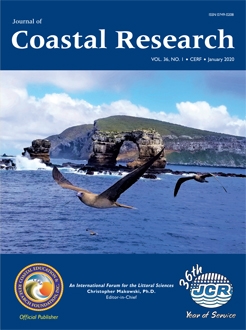Mattheus, C.R.; Ramsey, K.W., and Santoro, J.A., 2020. Evaluating continental shelf seabed-elevation changes from archived sediment-core records: Issues with vertical positioning and implications for integration with subsurface geophysics. Journal of Coastal Research, 36(1), 41–53. Coconut Creek (Florida), ISSN 0749-0208.
Sediment-core records from the sand ridge–dominated inner continental shelf of Delaware were studied to address impacts of seabed morphodynamics and positioning accuracy on data integration. Differences in vertical seafloor position were calculated for 366 point locations from core-report information (from 1984 to 2017) and a 2007 echo-sounding data set. Resulting net-change metrics were evaluated against seafloor geology and shelf zonation based on morphology. While gravelly units trended slightly towards net-elevation loss at an average of –0.2 m, shoal sand bodies averaged net-zero change. Almost 90% of change metrics fell within ±2 m, approximating the average relief of major shelf bed forms. A pairwise analysis of variance test revealed no statistically significant difference in vertical change at the 0.05 confidence level, based on geology, nor based on shelf zonation. Vertical positioning inaccuracies and reporting issues are primary concerns, even after quality control eliminated over 20% of available core records (total n = 466) because of undocumented tidal correction and vertical datum conversion procedures, which could have resulted in vertical offsets on the order of 2 m. Within the remaining data set, questionable values were recognized by a GIS-based buffer analysis, using core age and an assumed 10 m/y rate of bed-form migration to isolate metrics in disagreement with seafloor morphology. Data from three coring projects consistently overvalued net-change predictions, raising questions about their utility as stratigraphic benchmarks for ground-truthing seismic data. Accurate constraint of core depth is crucial for offshore resource allocation and infrastructure planning efforts, highlighting the importance of investigating vertical data resolution and addressing reporting inaccuracies.





